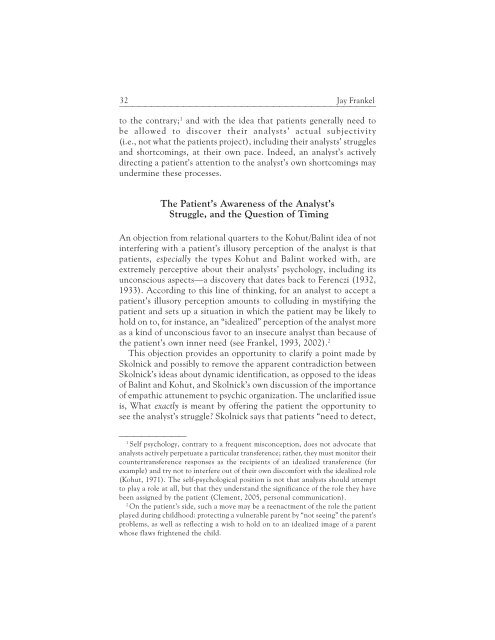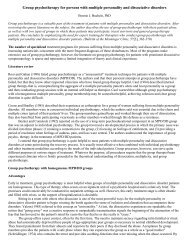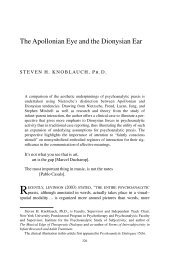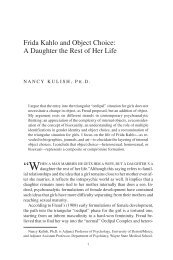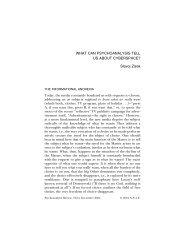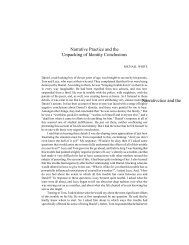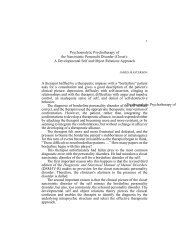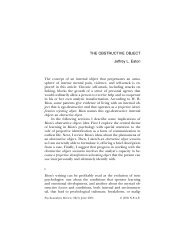What's a Good Object to Do? - PsyBC
What's a Good Object to Do? - PsyBC
What's a Good Object to Do? - PsyBC
You also want an ePaper? Increase the reach of your titles
YUMPU automatically turns print PDFs into web optimized ePapers that Google loves.
32 Jay Frankel<br />
⎯⎯⎯⎯⎯⎯⎯⎯⎯⎯⎯⎯⎯⎯⎯⎯⎯⎯⎯⎯⎯⎯⎯⎯⎯⎯⎯⎯⎯⎯⎯⎯⎯⎯⎯⎯⎯⎯⎯⎯<br />
<strong>to</strong> the contrary; 1 and with the idea that patients generally need <strong>to</strong><br />
be allowed <strong>to</strong> discover their analysts’ actual subjectivity<br />
(i.e., not what the patients project), including their analysts’ struggles<br />
and shortcomings, at their own pace. Indeed, an analyst’s actively<br />
directing a patient’s attention <strong>to</strong> the analyst’s own shortcomings may<br />
undermine these processes.<br />
The Patient’s Awareness of the Analyst’s<br />
Struggle, and the Question of Timing<br />
An objection from relational quarters <strong>to</strong> the Kohut/Balint idea of not<br />
interfering with a patient’s illusory perception of the analyst is that<br />
patients, especially the types Kohut and Balint worked with, are<br />
extremely perceptive about their analysts’ psychology, including its<br />
unconscious aspects—a discovery that dates back <strong>to</strong> Ferenczi (1932,<br />
1933). According <strong>to</strong> this line of thinking, for an analyst <strong>to</strong> accept a<br />
patient’s illusory perception amounts <strong>to</strong> colluding in mystifying the<br />
patient and sets up a situation in which the patient may be likely <strong>to</strong><br />
hold on <strong>to</strong>, for instance, an “idealized” perception of the analyst more<br />
as a kind of unconscious favor <strong>to</strong> an insecure analyst than because of<br />
the patient’s own inner need (see Frankel, 1993, 2002). 2<br />
This objection provides an opportunity <strong>to</strong> clarify a point made by<br />
Skolnick and possibly <strong>to</strong> remove the apparent contradiction between<br />
Skolnick’s ideas about dynamic identification, as opposed <strong>to</strong> the ideas<br />
of Balint and Kohut, and Skolnick’s own discussion of the importance<br />
of empathic attunement <strong>to</strong> psychic organization. The unclarified issue<br />
is, What exactly is meant by offering the patient the opportunity <strong>to</strong><br />
see the analyst’s struggle Skolnick says that patients “need <strong>to</strong> detect,<br />
⎯⎯⎯⎯⎯⎯⎯⎯⎯<br />
1<br />
Self psychology, contrary <strong>to</strong> a frequent misconception, does not advocate that<br />
analysts actively perpetuate a particular transference; rather, they must moni<strong>to</strong>r their<br />
countertransference responses as the recipients of an idealized transference (for<br />
example) and try not <strong>to</strong> interfere out of their own discomfort with the idealized role<br />
(Kohut, 1971). The self-psychological position is not that analysts should attempt<br />
<strong>to</strong> play a role at all, but that they understand the significance of the role they have<br />
been assigned by the patient (Clement, 2005, personal communication).<br />
2<br />
On the patient’s side, such a move may be a reenactment of the role the patient<br />
played during childhood: protecting a vulnerable parent by “not seeing” the parent’s<br />
problems, as well as reflecting a wish <strong>to</strong> hold on <strong>to</strong> an idealized image of a parent<br />
whose flaws frightened the child.


